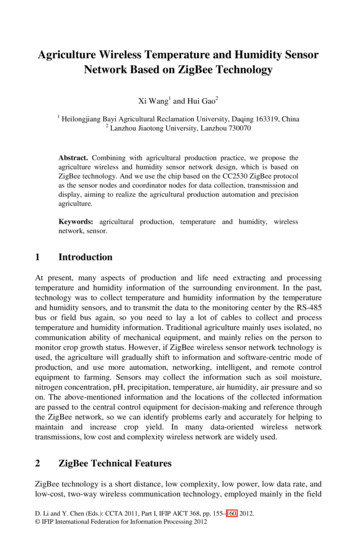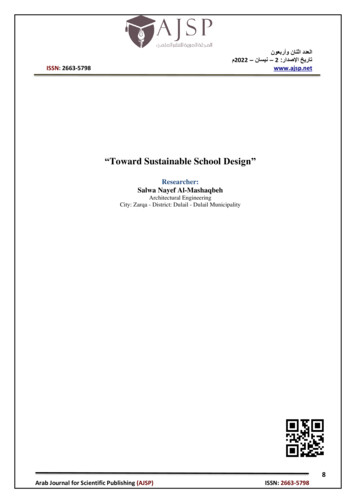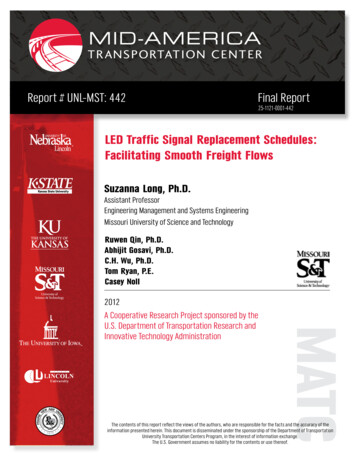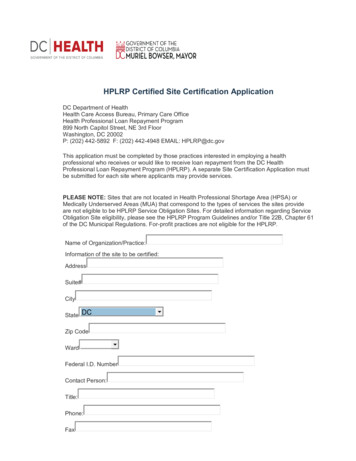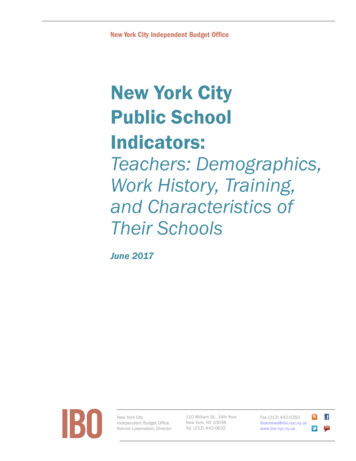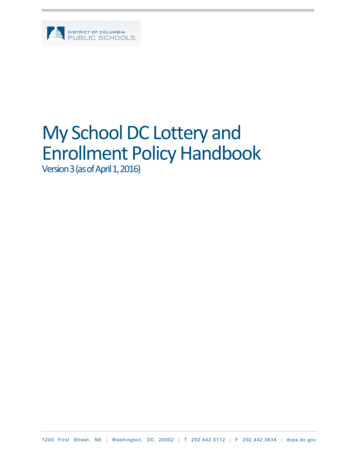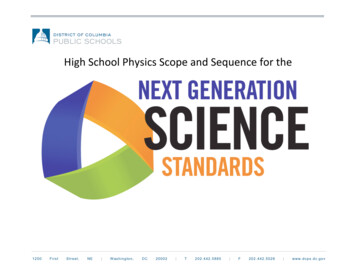
Transcription
Sustainable Product Lifecycle Managementand Territoriality: New Structure for PLMKiyan Vadoudi, Romain Allais, Tatiana Reyes, and Nadege TroussierICD, HETIC Department, CREIDD, Université de technologie de Troyes, UMR 6281,CNRS, Troyes, Francekiyan.vadoudi@utt.frAbstract. Product Lifecycle Management (PLM) is a business strategy, whichaims to streamline the flow of information about products and related processesthroughout the whole product’s Lifecycle such that the right information in theright context at the right time can be made available. Recently some studieshave been presented on general capabilities of PLM to improve sustainabilityparadigm, but the subject is still not solved completely. In this paper, first acritical review on the recent advances of Sustainable PLM is presented then anew structure for PLM is proposed based on combination of geographicalinformation systems (GIS) and Lifecycle assessment (LCA), to reach animprovement on sustainable development in territorial scale for achieving amore sustainable paradigm in global scale.Keywords: Product Lifecycle Management, Sustainable Development,Geographical Information Systems, Lifecycle Assessment.1IntroductionCompany, industrial ecosystem and territory are complex systems in interaction thatare organized according to their own specific goal. Although these objectives areusually divergent, sustainable development can be a common target for theseembedded systems [1]. Recently, there is a shift to manage the environmental andsocial impacts of products by PLM across the Lifecycle stages, which is calledSustainable Product Lifecycle Management (SPLM) [2-5]. It requires an in-depthunderstanding of semantics and structure of product Lifecycle information over thewhole Lifecycle from technical, social, cultural and geographical implications.Moreover, it is necessary to know which product Lifecycle information is requiredfrom where for each operational issue and each Lifecycle phase, and to classify theminto several types depending on their characteristics [6].Among the tools and methodologies available to evaluate the environmental,economic and social performance of materials and consumer products (including theirimpact on climate change and natural resources), Life Cycle Assessment (LCA)provides a holistic approach that considers the potential impacts from all stages ofmanufacture, product use and end-of-life [3]. Thus, it could be expectable to haveS. Fukuda et al. (Eds.): PLM 2014, IFIP AICT 442, pp. 475–484, 2014. IFIP International Federation for Information Processing 2014
476K. Vadoudi et al.different compliance status for a given product cause of different territorialcharacteristics (proximity to resources, land use, proximity to rivers, etc.) andregulations, which are emphasizing to make link with Geographical InformationSystems (GIS).This research purpose is to link GIS and PLM to have a global and systematicapproach to improve company sustainable performance and potential improvement ofsustainability at territorial scale. It argues on the necessity to take into account localinformation concerning where the business takes place. Then, from an informationsystem point of view, it argues the necessity to integrate geographical information inthe definition of products and processes, and in the whole PLM. It will lead to anintegrated data model including geographic and industrial system data.2Sustainable Development and TerritorialitySustainable development issues are manifesting themselves in various forms but anenvironmental issue is considered as a central point of sustainable development in aspatial setting. It leads to the necessity to specify more precisely the interactionsbetween different resource and industries. Such a more local and regional orientationis mandated not only by the character of the economic and environmental interactionsbut also by the spatial orientation of policies not only land use. In this regards, somecomprehensive impact models based on territory specification have to be developedthat encapsulate the complex interacting patterns of regional developments andrelated consumptions and emissions in relation with social, environmental, economicvariables in order to enable industrial decision making. It is noteworthy to mentionthat the spatial scale of analysis could be handled by Geographical InformationSystems (GIS) as a major tool in this field [5]. GIS techniques have beeninstrumental in developing interactive modes between quantitative modeling andspatial mapping [6] especially when regional development plans have a bearing on theterritory, GIS offers a powerful analytical tool for regional/spatial sustainabledevelopment [7].3The Geographical Information SystemsGeography seeks to understand the Earth with all of its human and naturalcomplexities that puts understanding of social and physical processes within thecontext of places and regions, recognizing the great differences in cultures, politicalsystems, economies, landscapes and environments across the world, and the linksbetween them [8]. Progress within geography as spatial science and integration withtechnical advances leads to develop a Geographical Information System (GIS), whichintegrates hardware, software and data for capturing, managing, analyzing anddisplaying all forms of geographically referenced information. Globally, there aremore than 2 million users of GIS and most companies are still unaware of how thistechnologies influences upon their daily activities [9].
Sustainable Product Lifecycle Management and Territoriality: New Structure for PLM477A GIS is essentially a tool for decision-making and its powerful analytical andvisualization capabilities provide the answers to important questions that must beanswered in order to make sound and to inform for decision making. A GIS allows usto develop models, create scenarios and ultimately provide solutions for variousenvironmental and socio-economic problems that exist [9]. Although GIS have beenused for several years in the natural resources, forestry, and environmental industries,only recently they have begun to be used for a broader array of business andmanagement functions such as logistics, site and facilities management, marketing,decision making and planning. GIS can help a retail business in locating the best sitefor its next store and helps marketers in finding new prospects [10].4Product LifecycleProduct Lifecycle thinking is an attempt to recognize whole stages of a product withinthe expected Lifecycle. From production engineering perspective, it is related with thedevelopment, production and distribution of the product, which can be defined bythree main phases: Beginning-of-life (BOL), Middle-of-life (MOL) and End-of-life(EOL) [11].BOL stage includes the initial design of a product, its development, testing andinitial marketing. During design phase by using many tools, techniques andmethodologies, designers, planners and engineers initial design of a product is definedand sent to manufacturing phase, which includes production process, plans,production facilities and manufacturing. The BOL stage is crucial to the sustainableproduct Lifecycle and elements such as the materials chosen and the processesrequired to create the product all have a significant impact on the product’s ultimateenvironmental footprint. MOL is including external logistic, use and support (in termsof repair and maintenance). In this phase, the product is in the hands of the finalproduct user/consumer and/or some service providers, maintenance and logistic actors[2]. Finally, in EOL, retired products are re-collected and remanufactured forrecovery. The product recovery processes consist in collecting, inspection,disassembly, reuse, remanufacturing, recycling, redistribution, and disposal. DuringBOL, the information flow is quite complete because it is supported by severalinformation systems like CAD/CAM, product data management (PDM), knowledgemanagement (KM). However, the information flow becomes vague or unrecognizedafter BOL which prevents the feedback of product-related information such asproduct usage data and disposal conditions, from MOL and EOL back to BOL.Hence, Lifecycle activities of MOL and EOL phases have limited visibility of theproduct-related information [12] considering the fact that sustainability in productdevelopment is tied with closed-loop flow of information.5Life Cycle AssessmentIn order to help designers in understanding and translating the environmentalconstraints into effective actions, Life Cycle Assessment (LCA) methodology has
478K. Vadoudi et al.been developed to enable the generation of more Eco-efficient design alternatives [3].Specifically it is a method to assess the environmental impact of a product during itsLifecycle, from the extraction of raw materials to the production and distribution ofenergy through the use, reuse, recycling and final disposal. LCA is a tool for relativecomparison and not for absolute evaluation, thereby it can be used by decision makersto compare all major environmental impacts in the choice of alternative courses ofaction [13]. The core phase of an LCA analysis is the Lifecycle Inventory compilationthat regards the identification of all input and output flows concurring in the productLifecycle [14]. The procedures of life cycle assessment (LCA) are part of the ISO14000 environmental management standards: in ISO 14040:2006 and 14044:2006[15-16].Regionalization, in the context of LCA, is the recognition that industrial productioncharacteristics and the environmental impact of environmental flows vary among sitegeneric, site-dependent, and site-specific assessments. Site-generic is globally valid,site-dependent operates on the regional scale, and site-specific is only locally applicable[15]. During the LCA modeling each subsystem of the Lifecycle is linked together intoa chain of processes, in one end extracting resources and in the other giving varioustypes of emissions or waste. This chain of linked processes is referred to as the technicalsystem. In reality a technical system is under some sort of human control and designedfor a certain purpose, to deliver a certain benefit or good, which in the LCA is expressedthrough the functional unit of the system. The processes are also located somewhere,which implies that they can be geographically referenced. Environmental impact causedby a technical system, or its LCA equivalent, the functional unit, is estimated in terms ofthe negative change implied by the technical system upon the environmental system, asevaluated by the social system. These systems may also be geographically referenced,which is an important starting point for a consideration of the relations between LCAand localized environmental impacts [14].6Product Lifecycle ManagementProduct Lifecycle Management as a business strategy makes it possible to manage thewhole Lifecycle of a product. It is ideally an organizationally information andknowledge processing system that integrates information-driven approach comprisedof people, processes/practices and technology to all aspects of a product’s life andprovides a central system to centralize product data, standardize business processesand streamline communication of information across distributed product developmentteams to shorten development cycles, improve quality and speed time-to-market [21].To be able to plan the implementation of PLM effectively into an organization, itneeds to be understood also the strategic aspect of PLM far more than just an ITsystem, to develop the company as a whole to integrate all organizational aspects andlevels. In this regard, Anneli Silventoinen [21] presented a holistic PLM model thatincludes five elements of strategies defining main approaches; operational processesof the value chain; structures of product, knowledge and organization; people andculture, and information technology means.
Sustainable Product Lifecycle Management and Territoriality: New Structure for PLM479Since Information and Communication Technology (ICT) plays an important rolein PLM, the ICT architecture of a company and its dynamic adaptation to newtechnological developments is necessary for realizing the full PLM potential. ICT isused in running the PLM processes and in up-dating of data and informationstructures, mainly for creation, acquisition, storing, sharing and application ofdocumented knowledge, but also for collaboration. In this regards different IT tools,platform and systems that are spread through complete Lifecycle of product aredividing in two categories of “ICT tools and systems” and “ICT interoperability andarchitectures”[2].Despite progresses in computer-aided design (CAD), computer-aidedmanufacturing (CAM), computer-aided process planning (CAPP), product datamanagement (PDM), enterprise resource planning (ERP), Lifecycle Assessment(LCA), which help to make decision in the design process, there are still shortcomingsin this stage because they were usually separated from a manufacturing company’smainstream operations and they cannot adequately address the need for collaborativecapabilities throughout the whole product Lifecycle and they usually focus on specialactivities in an enterprise, which are not adequately designed to meet new businessrequirements. Especially, Lifecycle Assessments (LCA) can feed PLM to improveglobal performance in a sustainable framework, but to have a represent-ability of themodel, it may be necessary to have the input data as specific as possible includinggeographic specificities [2].7Sustainable Product Lifecycle ManagementDuring recent years there is a shift to talk about Sustainable Product LifecycleManagement (SPLM) as an opportunity applying scientific knowledge to design andimplementing products and processes. N. Duque Ciceri [18] introduced PLM as aplatform to provide sustainability by continuous sharing of information among thedifferent product Lifecycle phases. He believes, there are two main challenges fordoing PLM as an effective tool for Sustainable Manufacturing; “closing productLifecycle information loops” and “defining a reference model for the PLM approachto sustainability and Sustainable Manufacturing in particular”. Kary Framling [19] byemphasizing more on environmental dimension based on closed-loop PLM,introduced intelligent products as an approach to reduce CO2 emissions, energy usageand environmental damage through the communication between products and othersystems. In that paper closed loop Lifecycle management is defined as a basisapproach for SPLM to improve environmental sustainability during all phases of theLifecycle it uses Life Cycle Assessment (LCA) as a methodological framework forestimating and assessing the environmental impacts and “energy informatics” foranalyzing the flow of energy between components of the whole system. Martin Eigner[17] proposed a solution for monitoring the sustainability of product developmentprocesses based on Integrated Sustainability Triangle. The Integrated SustainabilityTriangle, originally introduced as a promising new possibility of quantification andmonitoring the Sustainable Development of a national economy, is also anappropriate instrument for the systemization and evaluation of the performance of acompany regarding sustainability management. In next section a new structure forPLM is proposed, which tries to be better support of sustainability strategy.
4808K. Vadoudi et al.Improved PLM structureThis research methodology is based on a mere literature study, evaluating thepotential of using GIS in PLM structure by use of LCA as an interrelation tool toimprove sustainability in territorial scale, which can be seen as a pre-study todemonstrate and illustrate the impact of taking account of geographic information inPLM to design sustainable systems. Review of related works presented above aboutSPLM indicate that current PLM solutions for supporting sustainability are often notadequate for the management of product design information beyond BOL, MOL andEOL stages. One of the major problems about implementation and evaluation of thesustainable development is the lack of specificity in concrete circumstances. It meanssustainable development, which is implemented in a region, is not necessarilysustainable elsewhere and a large number of small-scale and marginal changes at thelocal or regional level have clear global dimensions. Thus, accessibility togeographical information can play critical role on quantification and monitoringsustainability in specific area and then running product development process based onresults of sustainability assessment. Therefore, it is essentially required to identify anddevelop a technology for current PLM structure as beginning in company scale toenable product development process based on the result of sustainability in regionalscale, in order to solve the issue of sustainability in global scale.The fact that businesses can start to use GIS within PLM is not surprising,particularly given the fact that much of the data that organizations typically useinclude significant spatial components (estimates range between 50% and 85%) [9].Researchers and professionals have seen the potential of using GIS in the planning fora sustainable development; by mapping the same factor in different time spans andspatial areas an overview of changes is created and hence make it easier and morecorrect to predict future changes and make well founded planning decisions in urbanareas [22]. By implementing GIS, “Territory” in macro level adds to the structure ofFig. 1. Improved ICT structure in product lifecycle
Sustainable Product Lifecycle Management and Territoriality: New Structure for PLM481PLM and makes it able to provide a proper catalog of the surroundingsincluding environmental impact on natural ecosystems, transportation, communitydemographics, public safety, utilities, services and accessibility (Fig.1).The nature of each geographical aspect is presented in the structure of LCA as thethree subsections of technical, environmental and social systems, which make linkbetween “production” and “process” scales with “territory” through the results ofLCIA. A technical system generally includes processes which might be geographicallyreferenced, and which are connected via different types of transport systems, such asgoods (road, sea, air) or energy ware (pipelines, electricity grid) distribution systems.The geographic location and extension of such a technical system gives relevantinformation for the modeling and assessment of its environmental impact [23]. Bygiving the geographical location of the different parts of the technical system, it willbe possible to model the dispersion of various agents, so that the varying sensitivity ofecosystems, regions, etc., can be taken into account where this is relevant. Ageographically large technical system and the environmental impacts of such a systemmay cross national, regional and even continental boundaries, and therefore alsoaffects different cultures or groups of people, holding different attitudes towardschanges in the environment.The amassing of these tangible elements of a community goes a long way towardinforming the design process, and should always be considered to look at efficiencyand sustainability. For instance, by using this new structure it would be possible todevelop companies’ energy consumption, water usage, CO2 emissions and wastesgeneration to build scenarios, assess them and make decision. When it comes to model,it will able companies to locate points of water usage, transportation of water from itssource to its consumption point, distance of water transportation, climate change, airpollutions, soil-map, location of landfill, customers distribution and other informationrelated with Lifecycle that can be useful in BOL to design product, process and plant(Fig.2). It will enable to enhance circular economy and industrial ecology.Fig. 2. Interaction between Product lifecycle, GIS, LCA and LCIA
482K. Vadoudi et al.By using sustainability monitoring, it will be possible to analysis the result of thisnew PLM structure. Several solutions for the monitoring of sustainability of productdevelopment processes have been developed but the one that is much more relatedwith PLM, is proposed by Martin Eigner based on integrated sustainability triangle[17] by a weighted aggregation of the single indicators to define the assertedcontribution of a respective field. Each field includes several indicators that maycontribute to a different extent to the outcome for that field but together all usedindicators illustrate 100% of the subject field. The result can present as an IntegratedSustainability Triangle to monitor the sustainability performance and supportscommunication via graphic elements. There is a shortcoming with this representationas every dimension of this triangle is dependant to another one. Moreover the singlescore evaluation of the three dimensions of sustainability is a “black box” and dataneeded locally are not directly reachable.To overcome this issue of reuse of the information, the French national agency(ANR) founded Convergence project propose a multi-level management system [24].The three-organization level of a company (i.e. top management, middle managementand operations) and their respective domain of action (i.e. strategy, tactics andoperation) are connected by a set of indicators dedicated to their daily activities. Adashboard extended to intangibles allows the evaluation and use of local and globalindicators to manage the positive and negative externalities of a company (I.E.sustainable performance). A future development is to systematize data collection byconnecting to PLM. When available, Convergence enables global performancemanagement for companies.Thus, it is essentially required to identify and develop a technology for current PLMstructure to enable product development process based on the result of sustainability inregional scale, in order to solve the issue of sustainability in global scale.9ConclusionsThere is no doubt that there is a lot of complexity in the sustainability concept. Apossible reduction of this complexity is a proper management, planning and designactions. Therefore, it can be concluded that a holistic management of resources ispresented in both consumption and production activities. The goal is to reach from amicro scale of design to macro scale to expand boundary beyond the factory wall tooptimize the resources utilization. In macro level businesses measure thesustainability level of same industry or territory to make decision for their designstages and this means they don’t think about themselves alone, but there is a higherlevel entity who is managing the sustainability as a whole. Vertical integration ofindustries, cross industry mix and community involvement could be subjects forfurther studies, in order to bring them into PLM structure by using geographicalinformation as driven cross industries.In summary, the paper shows that GIS should be included in PLM framework tolocalize environmental, economic and social, related to specific locations whendesigning green manufacturing systems.
Sustainable Product Lifecycle Management and Territoriality: New Structure for PLM483It will lead to the definition of an integrated framework (integration of geographicand industrial data) in order to support decision making, especially in BOL. It willenable both: Industrial ecology principles to be applied in BOL reasoning; Environmental impact assessment with respect to the local context.References1. Capron, M., Quairel, F.: Évaluer les stratégies de développement durable des entreprises:l’utopie mobilisatrice de la performance. l’organisation Responsable (2006)2. Terzi, S., Bouras, A., Dutta, D., Garetti, M.: Product lifecycle management–from itshistory to its new role. Int. J. Prod. Lifecycle Management 4, 360–389 (2010)3. Hart, A., Clift, R., Riddlestone, S., Buntin, J.: Use of Life Cycle Assessment to DevelopIndustrial Ecologies, A Case Study 83(4), 359–363 (2005)4. Glavič, P., Lukman, R.: Review of sustainability terms and their definitions. J. Clean.Prod. 15(18), 1875–1885 (2007)5. Burrough, P., McDonnell, R.: Principles of geographical information systems (1998)6. Maria Giaoutzi, P.N.: Decision support models for regional sustainable development,p. 304. Avebury, Brookfield, Vt, Ashgate Pub. Co., ldershot, Hants, England (1993)7. Nijkamp, P., Ouwersloot, H.: A decision support system for regional sustainabledevelopment: the flag model. Tinbergen Institute Discussion Paper (1997)8. Johnston, R.: Geography and GIS. Geogr. Inf. Syst. Princ, pp. 39–48 (1999)9. Azaz, L.: The use of Geographic Information Systems (GIS) in Business. In: Int. Conf.Humanit., pp. 299–303 (2011)10. Pick, J.: Geographic information systems in business. IGI Global (2004)11. Kiritsis, D., Bufardi, A., Xirouchakis, P.: Research issues on product lifecyclemanagement and information tracking using smart embedded systems. Adv. Eng.Informatics 17(3-4), 189–202 (2003)12. Niemann, S., Tichkiewitch, Westkämper, E.: Design of sustainable product life cycles.Springer (2008)13. Finnveden, G., Hauschild, M.Z., Ekvall, T., Guinée, J., Heijungs, R., Hellweg, S., Koehler,A., Pennington, D., Suh, S.: Recent developments in Life Cycle Assessment. J. Environ.Manage. 91(1), 1–21 (2009)14. Mutel, C.L., Pfister, S., Hellweg, S.: GIS-based regionalized life cycle assessment: howbig is small enough? Methodology and case study of electricity generation. Environ. Sci.Technol. 46(2), 1096–1103 (2012)15. ISO, 2006a. ISO 14040 International Standard. In: Environmental Management – LifeCycle Assessment – Principles and Framework. International Organisation forStandardization, Geneva, Switzerland16. ISO, 2006a. ISO 14044 International Standard. In: Environmental Management – LifeCycle Assessment – Principles and Framework. International Organisation forStandardization, Geneva, Switzerland (2006a)17. Eigner, M., Von Hauff, M., Schäfer, P.: Sustainable Product Lifecycle Management: ALifecycle based Conception of Monitoring a Sustainable Product Development. GlocalizedSolut. Sustain, pp. 2–7 (2011)18. Ciceri, N.D.: Product lifecycle management approach for sustainability. In: Proc. 19th, pp.30–31 (March 2009)
484K. Vadoudi et al.19. Främling, K., Holmström, J., Loukkola, J., Nyman, J., Kaustell, A.: Sustainable PLMthrough Intelligent Products. Eng. Appl. Artif. Intell. 26, 789–799 (2013)20. Dyllick, T., Hockerts, K.: Beyond the business case for corporate sustainability. Bus.Strateg. Environ. 11(2), 130–141 (2002)21. Silventoinen, A., Pels, H., Kärkkäinen, H., Lampela, H.: Towards future PLM maturityassessment dimensions (2011)22. Walsund, E.: Geographical Information Systems as a Tool in Sustainable UrbanDevelopment, Malmö University (2012)23. Vadoudi, K., Troussier, N., Zhu, T.W.: Sustainable Manufacturing through PLM, GIS andLCA interaction. In: International Conference on Engineering, Technology and Innovation,Bergamo, Italy (2014)24. Zhang, F., Rio, M., Allais, R., Zwolinski, P., Carrillo, T.R., Roucoules, L., Buclet, N.:Toward a systemic navigation framework to integrate sustainable development into thecompany. Journal of Cleaner Production 54, 199–214 (2013)
management functions such as logistics, site and facilities management, marketing, decision making and planning. GIS can help a retail business in locating the best site for its next store and helps marketers in finding new prospects [10]. 4 Product Lifecycle Product Lifecycle thinking is an attempt to recognize whole stages of a product within

